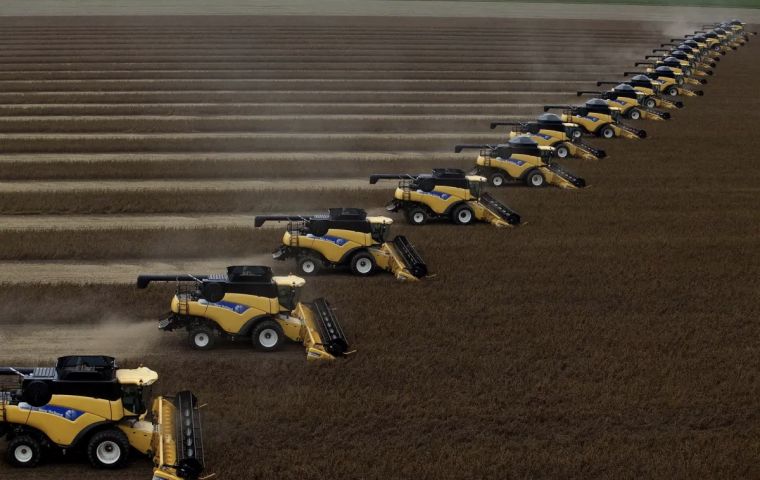MercoPress. South Atlantic News Agency
Brazil estimates a grains and oilseeds 2022/23 harvest of 308 million tons
 For soybeans, Conab points to a record production scenario. The projection is 150.36 million tons for the next season.
For soybeans, Conab points to a record production scenario. The projection is 150.36 million tons for the next season. Brazil's government CONAB, (National Supply Company) anticipated that the 2022/23 grains and oil seeds harvest would reach 308 million tons, given the good performance and strong international demand for corn, soybean, rice, beans and cotton.
“Despite the increase in production costs, the crops still have strong liquidity and represent good profits for Brazilian farmers,” said Guilherme Ribeiro, CONAB president. He added as shown in Conab’s Preliminary 2022/23 Agricultural Prospects report, these factors have contributed to allocation of more soil to soybean, corn, and cotton crops.
Besides the five crops, which correspond to more than 90% of Brazilian grain production, are estimated at 294.3 million tons.
For soybeans, Conab points to a record production scenario. The projection is 150.36 million tons for the next season. Prices should remain attractive as world supply and demand for the oilseed remain tight. This reflects a growing trend of 3.54% of the area for the crop, reaching 42.4 million hectares.
In the case of cotton, Conab’s analysis points to a scenario of an increase in crop area, productivity, and consequent hike in output. The first forecasts for the 2022/23 crop indicate a harvest of 2.92 million tons of the plume. Factors behind this trend are the high level of prices, good profit margin, and early commercialization, among others.
However, the uncertainties of the world economic scenario may restrict this growth. Nevertheless, given the production, the exported volume is expected to take an upturn and reach a level close to two million tons, in addition to building a carryover stock of approximately 1.75 million tons at the end of 2023.
For rice the cultivated area should show a further reduction in the 2022/23 harvest. With the high cost of production, farmers tend to opt for crops with better profits and liquidity estimates, such as corn and soybeans. Even so, production in the 2022/23 crop should reach 11.2 million tons, given the likelihood of better yields compared to 2021/22, which suffered from water scarcity for its good development. A similar scenario is expected for beans.
When it comes to corn, total production of 125.5 million tons is expected. The area reserved for corn crops is likely to decrease by 0.6% during the first annual harvest since it coincides with the soybean cultivation period. However, with a possible recovery in yields, after suffering from insufficient water in producing regions in 2021/22, total crop could reach 28.98 million tons.
In the second harvest of the grain, an increase in both area and productivity is estimated, resulting in a yield of 94.53 million tons, an expansion of 8.2% compared to the 2021/22 harvest.
As to the Animal Protein market, meat producers, especially poultry and pork producers, are faced with the challenge of managing production costs, given higher corn prices. In this scenario of high costs, the tendency is for a lower profit margin for the sector.
In the case of pig farming, another factor to be considered is the recovery of Chinese herds, hit by African swine fever from 2018 onwards. The plague has had an impact on domestic live pig prices. Naturally, decreased infection rates are leading to a reduction in exports to China.
“However, with the opening of new markets, such as in other Southeast Asian countries and Canada, the effects of this decline tend to be minimized,” says Allan Silveira, Conab's Market Studies and Supply Management chief.. The trend in 2023 is for an increase in slaughters of roughly 6.7%, which should not fully translate into an increase in protein production due to lower animal average weight projected due to high feed costs.
Poultry slaughters are expected to increase by 3.2% in 2023 compared to this year, reaching 6.29 billion chickens, while exports are expected to fall by 1.7%, reaching 4.5 million tons. This combination of factors results in a probable increase in domestic supply of 4.2%, increasing availability per capita of some 51 kg/inhabitant/year.
Despite a favorable external market situation, beef breeders are facing rising costs, mainly due to recent increases in the price of calves. In response to this price hike, breeders developed a strategy to retain females, which could explain the expected increase in herd figures for 2022 and 2023 and, consequently, the increase in slaughter rates in the upcoming months, up 2.7% from 2022 (30.1m cattle heads).
This increase in slaughter also indicates a 2.9% increase in beef production, owing to the possibility that in 2023 the process of culling cows, typical of the current stage of the livestock cycle, will begin, allowing for an increase of around 5% in sales to the foreign market and a slight increase in per capita availability in 2023, approaching 26 kg/inhabitant/year.




Top Comments
Disclaimer & comment rulesCommenting for this story is now closed.
If you have a Facebook account, become a fan and comment on our Facebook Page!